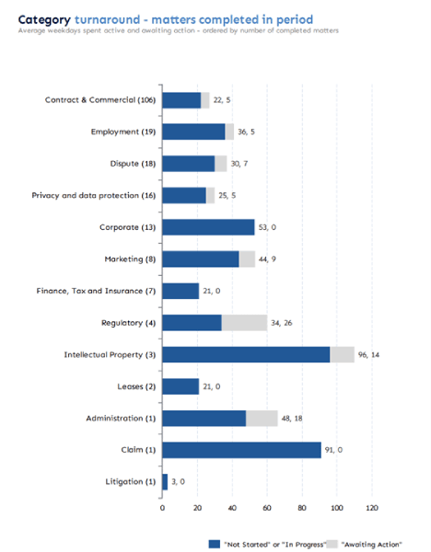When in-house legal teams engage external counsel to assist with a legal matter, it can be for a myriad of reasons, including:
- Lack of internal capacity
- A need for specialist legal knowledge
- The legal service delivery model is appropriate to the legal work type
- Matter complexity demands multiple disciplines and vast resources
Whatever the reason for outsourcing legal work to external counsel, the costs must justify the choice relative to other resourcing options, primarily the use of the in-house legal team. Ultimately, the goal of the in-house legal department is to match the right resources to each legal matter to ensure that the return on investment of the whole resourcing solution is maximized.
How to measure ROI on external resource engagements
How can legal matter management return on investment be measured for in-house legal teams to help maximize this return on investment?
Turnaround time
The speed with which legal matters can be resolved and returned to the business is an important measure of return. The wheels of business must turn quickly, and the legal department is there to grease those wheels or remove roadblocks where they might pop up. Any delay in returning contracts, advice, regulatory guidance or filings can hinder the achievement of strategic goals.
The measurement of turnaround time can be done through your matter management software by automating the calculation of date of legal request to the date of matter completion. To accurately measure one resourcing choice against another, work needs to be aggregated into similar work types with different resourcing solutions.
The chart below is an example of how you could run a report to show all work that has been resourced internally, and then again to show all work that has been resourced with external resources. Comparing the two would allow you to understand the turnaround time each were able to deliver for similar categories of work.

Quality of advice / resolution
 This can be difficult to measure but the most effective means of measuring this outcome is to rate the work with some commonly agreed standards within your legal team (see suggestion below). Aggregating this information will allow you to look across all the legal work that utilize external counsel and measure the quality of the advice given.
This can be difficult to measure but the most effective means of measuring this outcome is to rate the work with some commonly agreed standards within your legal team (see suggestion below). Aggregating this information will allow you to look across all the legal work that utilize external counsel and measure the quality of the advice given.
Ultimately legal matter resolution can be measured by whether your organization has achieved its strategic goals and been supported by the Legal Department in achieving those goals. Measuring the impact on these goals in your legal operations software and/or the quality of the advice given by your external counsel will assist you to understand the role that the legal resourcing solution played in achieving the end goal.
Opportunity cost
Recall that one reason for outsourcing legal work is lack of internal legal team capacity. In this case, the capability exists in the in-house legal team, but those resources are otherwise engaged. The question to be measured here is whether the return on internal resources are being maximized by their current use or better return would be achieved by redirecting the internal resources to the outsourced work.
Imagine, for example, that your internal resources are caught up on a wild rush of NDAs. Not rocket science, but they have a rinse and repeat model that is working to get them cranking through. A complex sales agreement lands on the desk for a major opportunity. Do you:
- Pull the internal team off NDAs and put them on the complex contract; or
- Outsource the complex contract so as not to disrupt the internal flow?
An extreme example to illustrate the point, but the measure to apply here is one of strategic value and complexity. Your legal matter management software should capture metrics around the strategic impact of your work, whether in-sourced or out-sourced and aggregating all this work to look at total impact by resource will give you clear indication of the effectiveness of your resourcing model.

Overall output of combined resourcing model
Sometimes a simple count will do! Legal matter management requires you to understand simple quantities of work being requested and delivered. You may weight work based on size, complexity, risk or strategic impact to help compare changes in resourcing models, but the output of your resourcing mix measured over a time period will help to understand the effectiveness of the resourcing model being utilized.

Maximize the ROI of your legal resourcing choices
In-house legal data doesn’t have to be difficult. Your legal matter management software should capture this information as part of your workflow and automate the analytics to allow you to measure the return on investment of your resourcing mix. If you need help considering your resourcing options – what should be outsourced, when and to whom – download a copy of our resourcing quadrant here.
Download the Legal Department resourcing quadrant now >
To learn more about Xakia's legal analytics software and how we can help you measure legal ROI on external counsel engagements, get in touch with the friendly team today for a demo, or sign up for a free 14-day trial.
